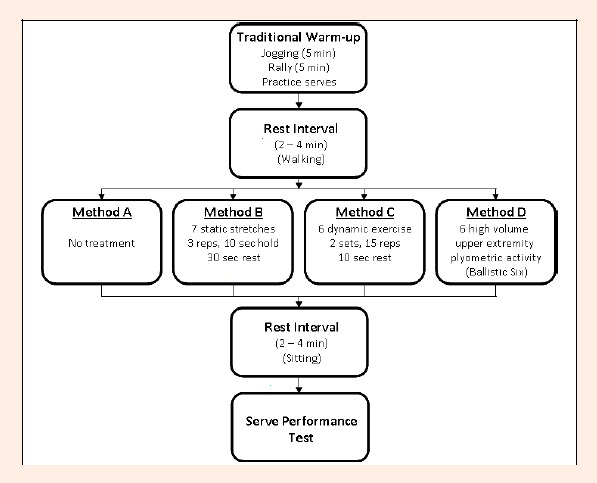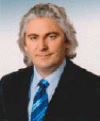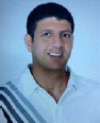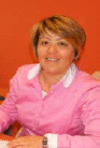Abstract
The purpose of this study was to compare the acute effects of static stretching; dynamic exercises and high volume upper extremity plyometric activity on tennis serve performance. Twenty-six elite young tennis players (15.1 ± 4.2 years, 167.9 ± 5.8 cm and 61.6 ± 8.1 kg) performed 4 different warm-up (WU) routines in a random order on non-consecutive days. The WU methods consisted of traditional WU (jogging, rally and serve practice) (TRAD); traditional WU and static stretching (TRSS); traditional WU and dynamic exercise (TRDE); and traditional WU and high volume upper extremity plyometric activity (TRPLYP). Following each WU session, subjects were tested on a tennis serve ball speed test. TRAD, TRSS, TRDE and TRPLYO were compared by repeated measurement analyses of variance and post-hoc comparisons. In this study a 1 to 3 percent increase in tennis serve ball speed was recorded in TRDE and TRPLYO when compared to TRAD (p< 0.05). However, no significant change in ball speed performance between TRSS and TRAD. (p> 0.05). ICCs for ball speed showed strong reliability (0.82 to 0.93) for the ball speed measurements.The results of this study indicate that dynamic and high volume upper extremity plyometric WU activities are likely beneficial to serve speed of elite junior tennis players.
Key points
After the traditional warm up in tennis, static stretching has no effect on serve speed.
Tennis players should perform dynamic exercises and/or high volume upper extremity plyometric activities to improve their athletic performance.
Key words: velocity, warm-up, power, potentiation, ball speed
Introduction
Tennis is one of the most popular individual sports in the world. During the training sessions, there is a lot of time spent for the tennis serve because of its great influence on success in the sport (Kovaks, 2007). In tennis, particularly the first serve, maximal effort muscular performance is vital to success and, therefore, appropriate warm-up (WU) is essential to high-level performance. A good WU cannot only improve performance but also prevent injuries due to strenuous moves during training and/or tournaments and so WU routines prior to exercise are a well-accepted practice. (Bishop, 2003; Holcomb, 2000).
One of the most important issues is selecting the best WU protocol (Mandengue et al., 2009). The most commonly used methods are static stretching or dynamically performed intensive exercises after jogging which are mainly based on aerobics (Bradley et al., 2007; Brandenburg et al., 2007; Faigenbaum et al., 2006; Franco et al., 2012; Gelen, 2010; Little and Williams, 2006; Young et al., 2004).
However, numerous studies have reported that static stretching exercises prior to maximal muscular activities actually decrease most measures of maximal muscular performance (Avela et al., 1999; Faigenbaum et al., 2006). It is interesting that many athletes and coaches include static stretching in WU protocols when experimental evidence shows stretching decreases or does not affect maximal muscular performance (McHugh and Cosgrave, 2010; Kay and Blazevich 2012).
Parallel to the elimination of static stretching in WU, researchers have begun to examine new WU protocols that take advantage of contraction history dependent neuromuscular factors like PAP and stretch-shortening cycle (SSC) (Faigenbaum et al., 2006; Gourgoulis et al., 2003; Thompsen et al., 2007). Throws, hops, skips and jumps form the basis of most WU exercises. Dynamic WU exercises include plyometrics, heavy load resistance exercises, or maximum voluntary contractions. Previous studies postulated that voluntary contractions from low to high intense level before any athletic activity can increase the force production and performance in the same way as dynamic WU exercises by activating neuromuscular potentiation (Faigenbaum et al., 2006; Güillich and Schmidtbleicher, 1996; Thompsen et al., 2007). This phenomenon is called ‘post-activation potentiation’ (PAP). PAP is defined as the temporary increase in muscle contractile ability after previous contraction sessions (Sale, 2004). One of the mechanisms that produce PAP is the interaction between actin-myosin as a result of the phosphorylation of light chain myosin, which is more effective. The other mechanism is neural excitability (Gossen and Sale, 2000; Sale, 2004).
The most common of the methods those produce PAP are plyometric activities. Plyometric exercises called the "Ballistic Six" were proposed by Pretz, 2004 to improve upper extremity muscular performance. Much has been written on the long term effects of ballistic six exercises (Carter et al., 2007). However, in this paper we study acute effects of the method.
The serve is the most important stroke in tennis that requires skilled use of the major muscles of the body (Knudson et al., 2004). During tennis serve, in order to achieve accurate serve, attributes such as force and speed might affect the shot. This study was designed to examine acute effects of pre-event static stretching, dynamic exercise and high volume upper extremity plyometric activities in tennis serve performance. It was hypothesized that static stretching reduces ball speed because of its negative effect, in contrast of this; high volume plyometric activities might help to increase ball speed in tennis serve performance.
Methods
Experimental approach to the problem
A within-subject, randomized, repeated-measures design was used to examine the acute effects of the WU methods on tennis serve ball speed. For all WU protocols, subjects began by jogging for 5 minutes at a target heart rate of 140 beats per minute and 5 minutes moderate intensity rally (also 30 seconds serve with no ball). The study consisted of 4 experimental sessions. At each session, subjects performed 1 of 4 different WU methods (i.e., (a) neither stretching, dynamic exercise nor plyometric exercises; only jogging and moderate intensity rally [TRAD], (b) static stretching [TRSS], (c) dynamic exercise WU [TRDE], and (d) high volume upper extremity plyometric activity [TRPLYO] and after the WU protocols subjects completed the tennis serve ball speed test.
Subjects
Twenty-six young and elite tennis players participated to the study as volunteers (15.1 ± 4.2 years, 1.68 ± 0.06 m, 61.6 ± 8.1 kg). All subjects had previous competitive tennis experience at national & international tournaments. They have also training experience of 8.4 ± 3.8 years. All subjects had no significant history of recent musculoskeletal injury.
The study was conducted consistent with the recommendations of the Declaration of Helsinki. Before participating to the study, the subjects were informed about the potential risks and benefits of the study. All applications and tests carried out during the competition session because of the competition strategy; trainings were designed without strength trainings or high volume exercises. The subjects had 10-hour training session per week. During the applications, subjects did not have any ergogenic supplement even caffeine intake on each testing day. The subjects prevented from the food consumption within the 2 hours before testing.
Procedures
Before collecting the data, the subjects were given an introduction about WU applications. They attended a trial session 2 days prior to the first test. The same trainer carried out all WU applications and all applications were performed at the same time of the day which was 16.00 p.m. All of 4 WU methods performed randomly on non-consecutive days. TRAD-TRPLYO applications started with 5 minutes of low intensity aerobics-based jogging. The low intensity jogging included in the study as it increased body temperature; however, this temperature data were not measured. The subjects were instructed to run for 5 minutes on the tennis courts at a heart rate of 140 beats per minute. The intensity of jogging was monitored by a heart rate monitor (810i Polar Electro Inc., Kempele, Finland). The jogging was followed by a 5-minute moderate intensity rally (forehand/backhand). At the end of the rally, the subjects’ practised serve swings without balls for 30 seconds at a moderate level. This was followed by 10 WU serve practise; 5 at an impetus of 60%, 2 at an impetus of 70% and one each at an impetus of 80%, 90% and 100%. A 10-second interval was given between each WU serve. All subjects performed 2-4 minutes’ walk for resting on the courts after jogging, rally and serve throws (active rest). The WU procedures were performed after walking. A tennis serve ball speed test conducted 2-4 minutes after the completion of all the warming up methods took approximately 20-35 minutes (TRAD 20 min, TRSS 35 min, TRDE 32 min and TRPLYO 34 min). All the study procedures completed within 15 days. A summary of experimental and testing procedures are shown in Figure 1.
Figure 1.

A summary of the experimental method.
TRAD included jogging, rally and serve throws, which are traditionally performed only in tennis (Common protocol for all methods). No stretching, dynamic style WU exercises or high volume upper extremity plyometric activities applied after these applications.
TRSS consisted of traditional WU exercise of jogging, rally, serve throws and 7 static stretching exercises aimed at upper extremity muscles (active and passive stretching). Static stretching methods performed 3 times at a slow pace with intense sensitivity level for ten seconds at ten second intervals in between. A 30-second interval was given between the moves. Static stretching protocol on certain muscle groups identical to that Alter, 1988 described in his protocol [posterior shoulder stretch #200, triceps stretch #224, shoulder external stretch #205, pectoralis, deltoid and biceps brachia stretch #196-222, forearm extensor stretch #231 and forearm flexor stretch #230] (Table 1). Team trainer monitored the subjects during each stretch to ensure that was performed correctly.
Table 1.
Static stretching exercises.
| 1) | Posterior shoulder press. One arm cross on the chest. The other arm’s hand stretches the other arm towards chest (#200) |
| 2) | Triceps stretch. One arm is stranded from elbow behind the head, the other hand stretches the other arm from elbow to backward.(#224). |
| 3) | Shoulder external stretch. The arm is in 90 degrees abduction position, elbow is also in 90 degrees flexion. Assistant with his/her one hand supports athlete’s elbow and with his/her another hand stretches the arm to backward from wrist (#205). |
| 4-5) | Pectoralis, Deltoid and Biceps Brachii Stretch. Both arms get up to backward without bending. Asistant gets both arms (#196) or one arm (#222) to the up from wrist. |
| 6) | Forearm extansor stretch. One of the arm is extended to the forward and provided to get extension position of the wrist. Other hand holds finger tips and stretches to backward. (#231). |
| 7) | Forearm fleksor stretch. One of the arm is extended to the forward provided to get flexion position of the wrist. Other hand holds finger tips and stretches to backward (#231). |
(#200, #224, #205, #196, #222, #231 are figure numbers of the reference) (Alter, 1988)
TRDE comprised of a traditional WU exercise for tennis; jogging, rally, serve throws and 6 dynamic WU exercises aimed at upper extremity muscles. Dynamic WU exercises performed in two sets of 15 repetitions one after the other. A 30-second interval between the sets and a 60-second interval between each move was given. All dynamic WU exercises performed with rackets in hands at the dominant area. Dynamic WU exercises consisted of external and internal shoulder rotation, pronation and supination when the arm was at a 90-degree angle abduction with the shoulder, body rotation exercises of forehand and backhand when the feet were parallel to one another (Table 2).
Table 2.
Dynamic warm-up exercises
| 1-2) | Internal/External rotation. The arm is in 90 degrees abduction, elbow is in 90 degrees flexion. The racket is swung firstly to the internal rotation and then external rotation. |
| 3-4) | Supination/Pronation. When the arm is in 90 degrees abduction, athlete swing the racket firstly to the supination position and then pronation position. |
| 5-6) | Trunk rotation. The legs are in open position like shoulder width. Athlete swing the racket from one side of the body (right trunk rotation) to the other side (left trunk rotation) |
TRPLYO comprised of traditional WU exercise for tennis; jogging, rally, serve throws and 6 plyometric activities (the ‘Ballistic Six’) aimed at upper extremity muscles. The subjects were instructed to use maximal effort to perform exercises using the ‘Ballistic’ method in order to decrease the amortization phase and to maximize the training effects of the stretch-shortening cycle (SSC). The ‘Ballistic Six’ exercises performed as a set of 20 repetitions. 60-second interval was given between the moves. The equipment used in the Ballistic Six exercises included Thera-Band (The Hygenic Corp., Akron, OH) latex tubing (red) and medicine balls (1kg for the single-arm exercises and 3kg for the 2-handed exercises). Ballistic Six used as an upper extremity plyometric activity consisted of external rotation of latex tubing, latex tubing 90/90 external rotation, overhead soccer throw using a medicine ball, 90/90 external rotation side-throw using a medicine ball, deceleration baseball throw using a medicine ball, baseball throw using a medicine ball (Table 3).
Table 3.
Upper extremity plyometric exercises (Ballistic Six).
| 1) | Latex tubing external rotation. Latex tubing’s one part is connected to the belly. Athlete’s other side is turned to the Latex tubing connection which is not throwing arm side. Athlete use a small towel under his/her throwing arm and pulls Latex tubing with 90 degrees angle. |
| 2) | Latex tubing 90/90 external rotation. Latex tubing is connected to the belly. Athlete get his/her arm at 90 degrees abduction, elbow at 90 degrees flexion and he/she turns his/her face to the Latex tubing’s connection and pulls with 90 degree angle |
| 3) | Overhead soccer throw. Athlete stays approx. 1m. opposite to the wall. 2-lb health ball is thrown to the wall with two hands from overhead. |
| 4) | 90/90 external rotation side-throw. Athlete’s throwing arm gets opposite position to the assistant. 2-lb health ball is thrown to asistant by athlete with one arm with 90 degrees angle. |
| 5) | Deceleration baseball throw. Asistant stays behind the athlete. 2-lb health ball is thrown to asistant by athlete with one arm with 90 degree angle |
| 6) | Baseball throw. Asistant stays in front of the athlete. 2-lb health ball is thrown to asistant by athlete with one arm with 90 degrees angle. |
Tennis serve performance test
Tennis serve performance was determined by the mean ball speed of successful first serves. All serves performed on indoor tennis courts to be able to keep the effects of weather conditions under control. Each subject was instructed to perform 10 serves at a maximal speed (first serve). The radar gun (SportsRadar 3600, Astro Products, Ontario, CA, USA) for measuring the speed of the ball was fixed on the opposite serve line. The distance between gun and players was about 2 meters. The accuracy of the radar was 0.1 km/h (0.03 m/s) for a field of 10 degrees wide. In other words, the accuracy of processing the speed estimate is typically 2% of the of the actual ball speed for SR3600 (www.sportsradar.com). It can measure maximum speeds if the radar is placed directly in line of the moving object . The radar in this study was placed according to the player’s arm height. Same setup was used in Zaparditis et al. (2007) and Chelly et al., 2010 studies.
The subjects were instructed to perform serves into the diagonally opposite serve box in accordance with the rules of tennis. In case of serves landed in the net or out of the serve box, ball speed data were not recorded. The serves for subjects who were right-handed served at the left serve box (from the right) and the ones who were left-handed served at the right serve box (from the left). All subjects were instructed to perform their serves at a maximal effort. To calculate average ball speed, the 2 lowest and 2 highest recorded ball speeds in each test were omitted and the average of the remaining 6 values was calculated (Cohen, et al., 1994).
Statistical analyses
Descriptive statistics (mean ± SD) formulated for the variables age, height, body weight, ball speed data were analysed. Data obtained for each of the 4 WU methods were analyzed using repeated measures analyses of variance (ANOVA). TRSS-TRPLYO used for the study group, whereas TRAD designed for the control group. When a significant F value achieved, post-hoc comparisons accomplished via a least significant difference (LSD) test to identify specific differences between WU conditions. An intra-class correlation (ICC Rs) calculated for each test measure after each of the 4 WU methods to examine the reliability of each test.
Results
The average and SD values of the serve velocity for different WU method were; TRAD 137.1 ± 6.28 TRSS 136.5 ± 6.66 TRDE 138.9 ± 6.94 TRPLYO 141.8 ± 7.01.
There were significant differences found (F(3,75)= 28.829; p < 0.05). And these differences were between TRAD and TRDE (p = 0.013), TRAD and TRPLYO (p = 0.001), TRSS and TRDE (p = 0.002), TRSS and TRPLYO (p = 0.001), TRDE and TRPLYO (p = 0.001). On the contrary no statistical differences between TRAD and TRSS was seen (p = 0.132). Reliability ICC Rs for the dependent variables were 0.82 to 0.93.
Discussion
The study has been conducted to reveal the acute effects of static stretching, dynamic WU exercises and high volume upper extremity plyometric activities on tennis serve ball speed after jogging, rally and serve targets. The outcome of this study were smilar to the previous studies where static stretching exercise aimed at upper extremity had no acute effect on ball speed and pitching performance (Haag et al., 2010), tennis serve performance (Knudson et al., 2004) upper-body muscular performance (Torres et al., 2008).
Specifically Haag et al., 2010 found that static stretching did not affect pitching speed and pitching hit statistically for baseball players. Knudson et al., 2004 stated that static stretching exercises did not affect serve speed and serve hit statistically for tennis players. Torres et al., 2008 claimed that static stretching did not affect upper body muscular performance.
In present study, dynamic exercises increased the serve ball speed by 1.23 ± 0.6 % and high volume upper extremity plyometric activities increased it by 3.33 ± 1.4 % (p = 0.013, p = 0.001 respectively. The outcome was supported by previous study where dynamic WUs aimed at upper extremity increased power and speed performance (Baker, 2003). Baker, 2003 reported in their study with sixteen rugby league players that high resistance exercises increased power output by 4.5%. The result resembles 3.33% serve speed increase achieved after high volume upper extremity plyometric activities.
Despite the fact that further studies in this field are required, dynamic exercises for the purpose of WU can increase force production by improving neuromuscular functions. This phenomenon is called PAP (Sale, 2004). Although the mechanisms that trigger PAP are being researched, current theories show that there are temporary chemicals, neuromuscular and mechanic changes to relieve contractions that occur on muscle tissues (Gossen and Sale, 2000; Güillich and Schmidtbleichher, 1996; Sale, 2004). Previous studies conducted in addition to ones where mechanisms cause potentiation showed that characteristics such as individuals training habits or type of fibril distribution can modify their ability to trigger PAP (Güillich and Schmidtbleichher, 1996; Sale, 2004). Young et al., 1998 stated in their study that they had added a 1-set of 5RM squat load to WU exercises and this led to a 2.8% increase in jumps. Gullich and Schidtbleicher (1996) stated that high intense voluntary contractions before the test resulted in 3.3% increase in vertical jumps. Gourgoulis et al., 2003, stated a 2.4% increase in jump performance as a result of multiple semi-squat exercises. In the studies mentioned above, it was proposed that dynamic load contractions before activities like vertical jumps which require high power, stimulated the nervous system and these allowed the explosive effort to be used up.
Conclusion
In present study, static stretching that was applied just after the traditional warm up in tennis has no effect on serve speed. So using of PAP that occurs as a result of dynamic exercises and high volume upper extremity plyometric activities creates a potential field to improve athletic performance. We can suggest that tennis players should perform dynamic exercises and/or high volume upper extremity plyometric activities.
In this study, subjects was young and their levels are different each other. In future study, more professional tennis player will be chosen to determine effects of stretching program on serve performance.
Biographies

Ertugrul Gelen
Employment
Associate Professor at the Scholl of Physical Education and Sport, Sakarya University, Sakarya, Turkey
Degree
PhD
Research interests
Resistance training and stretching technics, Training and coaching
E-mail gelen@sakarya.edu.tr

Muhittin Dede
Employment
Middle East Technical University Tennis Club Trainer, Ankara, Turkey
Degree
MSc
Research interests
Training and coaching
E-mail mhttndd@hotmail.com

Bergun Meric Bingul
Employment
Assistant Professor at the Department of Physical Education and Sport, Kocaeli University, Kocaeli, Turkey
Degree
PhD
Research interests
Applied Biomechanics, Training and coaching
E-mail bergunmeric@gmail.com

Cigdem Bulgan
Employment
Lecturer at the Department of Physical Education and Sport, Halic University, Istanbul, Turkey and PhD student at the Department of Health Science Institute, Physical Education and Sport, Ankara University, Ankara, Turkey
Degree
MSc
Research interests
Physical Conditioning, Applied Biomechanics, Training and coaching
E-mail cigdembulgan@gmail.com

Mensure Aydin
Employment
Assistant Professor at the Department of Physical Education and Sport, Kocaeli University, Kocaeli, Turkey
Degree
PhD
Research interests
Training and coaching, sports for disabled
E-mail mensureaydin@yahoo.com
References
- Alter M.(1988)Science of stretching. Champaign IL: Human Kinetics. [Google Scholar]
- Bishop D.(2003)A Warm up I: potential mechanisms and the effects of passive warm up on exercise performance. Sports Medicine 33, 439–454 [DOI] [PubMed] [Google Scholar]
- Avela J., Kyrolainen H., Komi P.V.(1999)Altered reflex sensitivity after repeated and prolonged passive muscle stretching. Journal of Applied Physiology 86, 1283-1291 [DOI] [PubMed] [Google Scholar]
- Baker D.(2003)Acute effect of alternating heavy and light resistances on power output during upper-body complex power training. the Journal of Strength and Conditioning Research 17, 493–497 [DOI] [PubMed] [Google Scholar]
- Bradley P.S., Olsen P.D., Portas M.D.(2007)The effect of static, ballistic, and proprioceptive neuromuscular facilitation stretching on vertical jump performance. The Journal of Strength and Conditioning Research 21, 223–226 [DOI] [PubMed] [Google Scholar]
- Brandenburg J., Pitney W.A., Luebbers P.E., Veera A., Czajka A.(2007)Time course of changes in vertical-jumping ability after static stretching. International Journal of Sports Physiology and Performance 2, 170–181 [DOI] [PubMed] [Google Scholar]
- Carter A.B., Kaminski T.W., Douex A.T., Jr, Knight C.A., Richards J.G.(2007)Effects of high volume upper extremity plyometric training on throwing velocity and functional strength ratios of the shoulder rotators in collegiate baseball players. the Journal of Strength and Conditioning Research 21, 208–215 [DOI] [PubMed] [Google Scholar]
- Chelly M.S., Hermassi S., Shephard R.J.(2010) Relationships between power and strength of the upper and lower limb muscles and throwing velocity in male handball players. The Journal of Strength and Conditioning Research 24, 1480-1487 [DOI] [PubMed] [Google Scholar]
- Cohen D.B., Mont M.A., Campbell K.R., Vogelstein B.N., Loewy J.W.(1994)Upper extremity physical factors affecting tennis serve velocity. The American Journal of Sports Medicine 22, 746–750 [DOI] [PubMed] [Google Scholar]
- Faigenbaum A.D., Kang J., McFarland J., Bloom J.M., Magnatta J., Ratamess N.A., Hoffman J.R.(2006)Acute effects of different warm-up protocols on anaerobic performance in teenage athletes. Pediatric Exercise Science 18, 64–75 [Google Scholar]
- Franco B.L., Signorelli G.R., Trajona G.S., Costa P.B., de Oliveria C.G.(2012)Acute effect of three different stretching protocols on the Wingate test performance. Journal of Sports Science and Medicine 11, 1–7 [PMC free article] [PubMed] [Google Scholar]
- Gelen E.(2010)Acute effects of different warm-up methods on sprint, slalom dribbling, and penalty kick performance in soccer players. The Journal of Strength and Conditioning Research 24, 950–956 [DOI] [PubMed] [Google Scholar]
- Gossen E.R., Sale D.G.(2000)Effect of postactivation potentiation on dynamic knee extension performance. European Journal of Applied Physiology 83, 524–530 [DOI] [PubMed] [Google Scholar]
- Gourgoulis V., Aggeloussis N., Kasimatis P., Mavromatis G., Garas A.(2003)Effect of a submaximal half-squats warm-up program on vertical jumping ability. The Journal of Strength and Conditioning Research 17, 342–344 [DOI] [PubMed] [Google Scholar]
- Güillich A., Schmidtbleichher D.(1996)MVC-induced short-term potentiation of explosive force. New Studies in Athletics 11, 67–81 [Google Scholar]
- Haag S.J., Wright G.A., Gillette C.M., Greany J.F.(2010)Effects of acute static stretching of the throwing shoulder on pitching performance of national collegiate athletic association division III baseball players. The Journal of Strength and Conditioning Research 24, 452–457 [DOI] [PubMed] [Google Scholar]
- Holcomb R.W.(2000)Stretching and warm-up. In: Essentials of Strength Training and Conditioning. Eds: Baechle T.R., Earle R.W.Champaign, IL: Human Kinetics.322–329 [Google Scholar]
- Knudson D.V., Noffal G.J., Bahamonde R.E., Bauer J.A., Blackwell J.R.(2004)Stretching has no effect on tennis serve performance. The Journal of Strength and Conditioning Research 18, 654–656 [DOI] [PubMed] [Google Scholar]
- Kovacs M.S.(2007)Tennis physiology: training the competitive athlete. Sports Medicine 37, 189–198 [DOI] [PubMed] [Google Scholar]
- Little T., Williams A.G.(2006)Effects of differential stretching protocols during warm-ups on high-speed motor capacities in professional soccer players. The Journal of Strength and Conditioning Research 20, 203–207 [DOI] [PubMed] [Google Scholar]
- Kay A.D., Blazevich A.J.(2012)Effect of acute static stretch on maximal muscle performance: a systematic review. Medicine and Science in Sports and Exercise 44(1), 154–164 [DOI] [PubMed] [Google Scholar]
- McHugh M.P., Cosgrave C.H.(2010)To stretch or not to stretch: the role of stretching in injury prevention and performance Scandinavian Journal of Medicine & Science in Sports 20(2), 169–181 [DOI] [PubMed] [Google Scholar]
- Mandengue S.H., Miladi I., Bishop D., Temfemo A., Cissé F., Ahmaidi S.(2009)Methodological approach for determining optimal active warm-up intensity: predictive equations. Science and Sport 24, 9–14 [Google Scholar]
- Pretz R.(2004)Ballistic six plyometric training for the overhead throwing athlete. Strength and Conditioning Journal 26, 62–66 [Google Scholar]
- Sale D.(2004)Postactivation potentiation: role in performance. British Journal of Sports Medicine 38, 386–387 [DOI] [PMC free article] [PubMed] [Google Scholar]
- Thompsen A.G., Kackley T., Palumbo M.A., Faigenbaum A.D.(2007)Acute effects of different warm-up protocols with and without a weighted vest on jumping performance in athletic women. The Journal of Strength and Conditioning Research 21, 52–56 [DOI] [PubMed] [Google Scholar]
- Torres E.M., Kraemer W.J., Vingren J.L., Volek J.S., Hatfield D.L., Spiering B.A., Ho J.Y., Fragala M.S., Thomas G.A., Anderson J.M., Hakkinen K., Maresh C.M.(2008) Effects of stretching on upper-body muscular performance. J the Journal of Strength and Conditioning Research 22, 1279-1285 [DOI] [PubMed] [Google Scholar]
- Young W., Clothier P., Otago L., Bruce L., Liddell D.(2004)Acute effects of static stretching on hip flexor and quadriceps flexibility, range of motion and foot speed in kicking a football. Journal of Science and Medicine in Sport 7, 23–31 [DOI] [PubMed] [Google Scholar]
- Young W.B., Jenner A., Griffiths K.(1998)Acute enhancement of power performance from heavy load squats. The Journal of Strength and Conditioning Research 12, 82–84 [Google Scholar]
- Zapartidis I., Gouvali M., Bayios I., Boudolos K.(2007)Throwing effectiveness and rotational strength of the shoulder in team handball. The Journal of Sports Medicine and Physical Fitness 47, 169–178 [PubMed] [Google Scholar]


